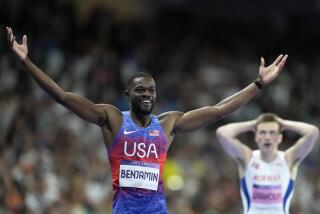The Unstoppables
- Share via
IN 1975, at age 53, Palos Verdes explosives manufacturer Bill Bell heard the 14 words that changed his life: “I want you to jog 40 minutes a day for three days a week.”
A stress test had detected an irregular heartbeat, and the doctor felt that sustained aerobic activity such as running -- not Bell’s old love, golf -- would fix the problem. So the man who hadn’t worked out for 35 years ran. “And it felt so good that I came back and asked him if I could run every day,” he says.
With the doc’s nod, Bell immersed himself in the running boom sweeping America. He ran with his dog. He ran with new running friends he met on the roads and trails. He ran the Palos Verdes Marathon. He began logging 11 to 12 miles before work every day and began building an athletic resume of 158 marathons and ultra runs, including 14 marathons in one year. Running was his health insurance, his soothing refuge from the stressful entrepreneurial business wars, and his teenage payback. “In my mind,” he said, “I was earning the letterman’s sweater I never got in high school.” (His dad’s death forced him, starting at 15, to work a double paper route rather than play sports.)
Before long, the father of three and grandfather of eight would set his sights on the most exalted “letterman’s sweater” in the endurance sports world: A Hawaii Ironman finisher’s T-shirt.
Today, he has 17 of them -- 32 counting non-Hawaii Ironmans.
Bell first saw one on the streets of Honolulu during a layover to Taiwan in 1981. “The guy wearing it, hearing my questions, seeing my excitement, just looked at me and said, ‘Go get some goggles and a bike.’ ”
It wasn’t that simple. He hadn’t bicycled since his paper route days. On his first day of swimming class at El Camino College, the 59-year-old could barely complete six laps. After he flew to Kona and lined up at the Hawaii Ironman start line in February 1982, he struggled during the 2.4-mile swim and suffered a broken chain and flat tire in the middle of the 112-mile bike leg. Ultimately, he missed the 12 1/2 -hour bike cutoff and was not allowed to run the marathon.
“But I don’t accept the word ‘can’t,’ ” Bell says. “I trained even harder.” In the next Hawaii Ironman, he took third place in his age group. He went on to win his age group four times.
Except for a thyroid condition in 1989 and 1990 that left him too fatigued to race, and one race in which he finished just after the 17-hour time limit, Bell officially completed the Hawaii Ironman every year through 2001. That year at age 79, he became the oldest person to finish the race -- until 2005, when Robert McKeague, 80, of Villa Park, Ill., took that honor.
For many in the triathlon world and millions on TV, Bell’s signature moment came in 1995 at age 72. Utterly fatigued by a day of biking against some of Kona’s worst-ever mumuku headwinds, he entered the 50-yard finisher’s shoot on Ali’i Drive with the time limit ticking away and saw his wife, Margie, waving from behind a police barrier. Seconds before midnight, weak as a lamb, he fell over when she draped a lei over his head. Helped up, he fell again. And again.
“My legs would not cooperate,” he said. He crawled and, summoning his last erg of energy, thrust an outstretched hand onto the finish line and lay there unmoving -- 2 minutes and 35 seconds over the 17-hour cut-off. The next year, Bell finished on time. Then, to thunderous applause, he recrossed the line and crawled back over.
Through 2002, when he finished in 16:57:00 at the Oceanside Ironman, Bell successfully completed dozens of Ironman races. But after that, shortness of breath -- later identified as exercise-induced asthma -- began to prevent him from finishing on time. “The swim was leaving me so wasted that I’d have nothing left on the bike and run,” he said. So in 2003, at 80, he retired from Ironman competitions -- but not from triathlon.
Bell is still is a fixture at a dozen or more Olympic distance and sprint races a year. At the Tinsel Triathlon in December, he received a plaque for being the oldest finisher. The last of the “IronGents,” a group of age 60-plus athletes who bonded in the early days of Ironman and once rode a 3,000-mile bike relay in the Race Across America, Bell refuses to fade away, training 12 to 20 hours per week all year from his Indian Wells home.
“My advice to anyone is simple,” Bell says. “Keep moving. I call it the ‘lawnmower theory.’ If you leave a lawnmower out on the grass and it rains, you better get out and push that thing before it gets rusty. I’m creaky and rusty every day when I get up in the morning, but after I get moving, I feel pretty damn good.”
More to Read
Sign up for The Wild
We’ll help you find the best places to hike, bike and run, as well as the perfect silent spots for meditation and yoga.
You may occasionally receive promotional content from the Los Angeles Times.






